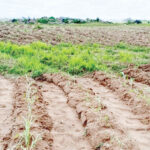The recent burst of the Alau dam, located 15 kilometers outside Maiduguri, which led to flood which submerged more than half of the capital city, has catastrophic consequences for Borno State, and to a substantial extent, the entire Nigeria.
The reservoir’s embankment collapsed for the second time in the last 30 years, releasing about 112 billion liters of water on lower locations of Maiduguri metropolis and Jere Local Government Area.
Since September 10, when the calamity drained about 70 per cent of the water out of the reservoir, farmers, fishers, herders and millions of residents, who have, for decades, depended on the water for drinking and numerous economic ventures, watch helplessly and haplessly as the water continues to drain out.
The tragedy impacted farming, fishing and cattle-rearing communities and several other groups of people who conduct economic activities around the dam.
With this development, food insecurity looms over Borno, and to a considerable extent, the neighbouring states.
The development has also affected the provision of potable water to over 40 per cent of Maiduguri metropolis.
Weekend Trust gathered that the reservoir pumps exactly 584 litres of water per second for home and commercial uses in the capital city, which translates to 50,457,600 litres within 24 hours.
“Every second, we used to pump 584 litres of treated water into Maiduguri, which translates to 2,102,400 per hour and 50,457,600 litres per day.
“As the reservoir shrank, we reduced the supply hours to 17, 15, and presently, 13 because the seepage could not allow the reservoir to be reasonably recharged.
“That is why we wrote to the state government on the need for a quick action to save the water from drying up. You can see their heavy duty trucks and excavators trying to salvage the situation,” one of the engineers on site said.
Our correspondent gathered that the development has led to the loss of revenue hitherto accruing to Borno State. Our correspondent, who visited the dam, observed that grasses have started taking over the reservoir. Most of the villagers interviewed said they were not used to the present situation.
The dam, which used to be 9 meters (30 ft) high and has a reservoir area of about 50 square kilometers (31 square miles and 4.0 billion cubic feet), had silt deposits after the flood.
Some of the engineers on site, who pleaded for anonymity, told our correspondent that the silting seriously affected the dam’s retention capacity.
“The flood brought a lot of sand and filled up the capacity of the dam, which is 112 million cubic meters (4 billion cubic feet), but not more than one quarter of this is retained. So, the silt needs to be dredged so that we can restore the full capacity of the dam,” he said.
‘We need help’
A 65-year-old Bunu Mairambe, who lives in Alau community, said although people displaced by the flood were gradually returning, they were subjected to untold hardship as farming is their major occupation.
He said, “Farming is the only occupation I have to feed my wives and 17 children, but the flood washed away all the millet, guinea corn, maize and cowpea we worked so hard to grow. The farms were completely washed away.
“Until this time, I had never missed the yearly rain-fed and dry season farming. Now, the water we relied so much on for irrigation purposes is drying up, plunging over 300,000 people here into difficulties.
“We want the government to come to our aid by drilling boreholes and supporting us with water pumps, fertiliser and seeds to recover from our loss.
“Similar flood happened 30 years ago, but the quantum of damage recorded then was not close to what happened to us this time.”
Mairambe said he had a very large family and could not rely on government handouts to survive.
Usman Mala blamed the government for what he called its failure to take prompt action to avert the situation despite repeated warnings by the community.
He said, “When the water level reached its peak, government officials came from Maiduguri with heavy duty trucks trying to help us sand-fill the cracking part of the dike.
“We joined them to work for three days, but our efforts were overpowered and there was a devastating damage to our orchards and farms.
“Now, the water has drained but we have nowhere to cultivate the sweet potatoes and other vegetables as we used to do over the past decades. The flood has turned our farms into dessert.
“We are now searching for soft areas to plant cassava as it is the only thing we can cultivate in our destroyed farmlands to withstand drought. My target is to harvest it and sell before the rainy season sets in so as to use the money for the rain-fed agriculture.”
A female farmer, Hadiza Mohammed Alau, who could not locate her farmland, said the flood hit her family from different fronts.
“We are in a very dire situation. My farm and that of my husband were submerged and all our crops washed away.
“Our vegetable farm was destroyed; and today, we are left with nothing to fall back on. We want the government to support us. We are faced with hunger; and starvation is imminent if we do not get the needed support,” she said.
Fishermen migrate
Our correspondent was told that since the dam has dried up, fishing activities were forced to stop; hence fishermen had no option than to migrate.
Musa Mai-Kifi, one of the fishermen who said he had spent decades of uninterrupted fishing in Alau, lamented that the continuous seepage of the reservoir threatened their occupation.
“The water is draining very fast. And no fisherman can do without water; that’s why both the fish catchers and buyers are leaving to other locations.
“More than a million people depend on this dam for their livelihood, but more than 50 per cent have given up. We are waiting to see if this embankment project by the state government would yield results.
“Also, if the Chad Basin does not reconstruct the water spillway before March next year, we are likely going to experience another catastrophic flood, in fact worse than the previous one,” he warned.
Water scarcity hits Maiduguri
Alau dam is called the “lifeline of Maiduguri” because it provides 40 per cent of potable water for residents, but unfortunately, after the flood, they have been hit by scarcity as water stopped flowing into their homes.
Lamenting the situation, a resident of Bulabulin, Benisheikh Street, Bukar Ali said, “We don’t have drinking water. We have a reservoir here but the water has turned black, so we are afraid to use it. We now buy 25 litres jerry-can at N100.
“We can’t afford to be buying water at this cost, let the government know our situation and fix the supply. We will abide by their terms. All we need is to have the water rush in our homes.”
Another resident of Bulabulin, Nuri Mohammed Mustafa, said, “I need between N1,500 and N2,000 every day to buy 12 kegs (25kg) of water from cart pushers who fetch from a long distance”.
This means that Mustafa would spend N45,000 monthly to get water for his household.
The youth leader of Bulabulin, Babagana Mustapha, also said the community was going through a horrifying experience, and called on the government to come to their aid. He, however, added, “We have to appreciate Governor Zulum for all the wonderful things he has been doing for us since the flood; but water is life, so we still want him to do more.”
Borno government’s efforts
Weekend Trust reports that the efforts by the Borno State government to salvage the situation by shipping truckloads of boulders, sand and gravels to block the water flow may not be yielding the needed results.
One of the engineers on site who pleaded anonymity, expressed fear that the temporary earth embankment they struggled to build would not stop seepage from the dam.
“It is very difficult to control this seepage; we can only reduce it so that the water does not drain completely.
“We used to pump 584 litres of treated water per second into Maiduguri, which translates into 50,457,600 litres per day, but we reduced the number of hours to 17, 15, and presently, 13.
“If the earth dike had not been constructed to reduce the seepage, we would not have had water supply to Maiduguri, because when a similar disaster befell us in 1994, the reservoir almost dried up.
“What we did was to use pumping machines to draw water from the downstream and fill the reservoir before we treated and supplied it to the town,” he said.
When contacted on the situation, the Borno State Commissioner for Water Resources, Tijjani Goni, declined comments, saying the project belongs to the federal government. He, however, said he would speak if authorised by the governor.
However, in a statement the commissioner released, he announced a temporary rationing of water in some areas of the state capital, Maiduguri.
He said engineers from the ministry were carrying out repairs and maintenance work on faulty facilities.
“The pumping of water will be temporarily rationed for two-day intervals in some areas, pending permanent repairs and maintenance work on the water facilities,” he said.
When contacted to speak on the matter, the acting managing director of the Chad Basin Development Authority (CBDA), Mohammed Zannah, an engineer, declined, saying the issue of Alau dam was at a committee level.
“We submitted our report to the minister waiting for the outcome, so I will not speak on it,” he said.
Weekend Trust reports that three months after the incident and five months to the rainy season, nothing tangible appears to be on ground to address the situation.

 Join Daily Trust WhatsApp Community For Quick Access To News and Happenings Around You.
Join Daily Trust WhatsApp Community For Quick Access To News and Happenings Around You.


